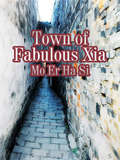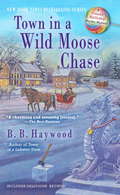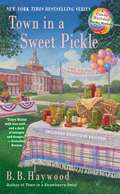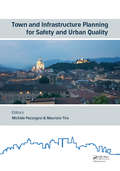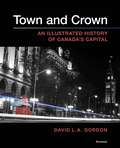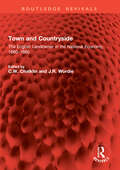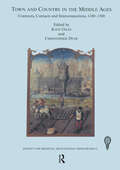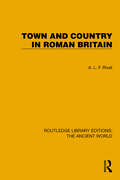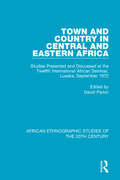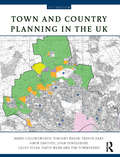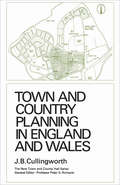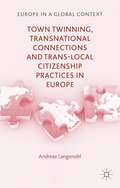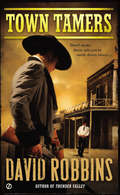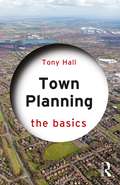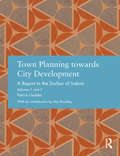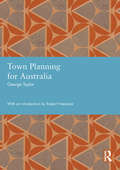- Table View
- List View
Town of Fabulous Xia: Volume 1 (Volume 1 #1)
by Mo ErHaSiThe town of Chihuahua, which was called Chihuahua, had never produced a hero. Generation after generation, it was just farming for a living. A pair of orphans grew up in the village with the help of their fellow villagers until the sound of gunshots rang out. [Close]
Town in a Wild Moose Chase
by B. B. HaywoodCape Willington's annual Winter Moose Fest is in full swing when the sightings of a mysterious white moose-and rumors of a dead body found in the woods-send Candy scrambling to separate fact from fiction before she finds herself in the bullseye of a ruthless killer...
Town in a Sweet Pickle (Candy Holliday Mystery #6)
by B. B. HaywoodWhen Candy organizes a cooking event for her local newspaper, the town's most prominent citizens turn out to witness the popular cookbook author Julia von Fleming serve as a guest judge. But when Julia comes close to consuming a poisoned pickle, she begins to suspect someone in Cape Willington is trying to kill her--and Candy is completely jarred to be among the suspects. <P><P>But the first taste was just a sample, and soon more jars of poisoned pickles begin to pop up around town. In the face of a pickled poisoning spree, Candy will have to track down the culprit to make sure her own name stays well-preserved. Along the way, she'll pull the lid off a briny barrel of blackmail, thievery, and revenge that's been souring their seaside hometown for years...INCLUDES DELICIOUS RECIPES!
Town in a Strawberry Swirl (Candy Holliday Mystery #5)
by B. B. HaywoodIn the quaint seaside village of Cape Willington, Maine, Candy Holliday has a mostly idyllic life, tending to the Blueberry Acres farm she runs with her father and occasionally stepping in to solve a murder or two...Summer has arrived! <P><P>But as the community gears up for another festive strawberry-picking season, the villagers are shocked when local berry farmer Miles Crawford is found dead in a hoophouse near his strawberry fields. Rumors have been swirling around about a secret real estate deal between Miles and Lydia St. Graves. And now Lydia is missing after she was seen fleeing the scene of the crime...<P>When Henry "Doc" Holliday becomes involved in the mystery, his daughter Candy finds herself caught in the jam as well. But things turn very sticky when Lydia suddenly reappears and asks for Candy's help in finding the true murderer...INCLUDES DELICIOUS RECIPES!
Town in a Pumpkin Bash
by B. B. HaywoodIn the quaint seaside village of Cape Willington, Maine, Candy Holliday has a mostly idyllic life, tending to the Blueberry Acres farm she runs with her father and occasionally stepping in to solve a murder or two... Halloween is fast approaching, and preparations for the Pumpkin Bash, Cape Willington's annual autumn festival, are well underway. Candy is running this year's haunted hayride, in the hopes of making some extra cash. But when she discovers a real dead body near some fake tombstones, Candy's side job becomes a full-blown investigation to find out who turned a holiday attraction into a real horror show. Will Candy's keen eye for detail unearth buried town secrets? As her search leads her through old graveyards and a haunted house, Candy will discover that not all of the skeletons hidden in this small town's closets are Halloween decorations... INCLUDES DELICIOUS RECIPES!
Town in a Maple Madness
by B. B. HaywoodThe New York Times bestselling author of Town in a Cinnamon Toast returns to Cape Willington, Maine, where blueberry farmer Candy Holliday springs ahead into sleuthing...The imminent arrival of spring has the locals gearing up for their sweetest celebration ever—the first annual Maple Madness Weekend. Along with maple sugar house tours, a community-wide marshmallow roast, and a weekend-long pancake breakfast, restaurants will be serving up special maple syrup dishes. But the weekend festivities are put in jeopardy when things start to get sticky... One of Candy’s friends is accused of stealing sap from a rival’s sugar maple trees, and landscaper Mick Rilke is found dead, floating down the river wrapped up in a fisherman’s net. As Candy taps into Mick’s life, his unsavory side comes to light, as well as a possible connection to both crimes. Now it’s up to Candy to follow the flow of suspects to a cold-blooded killer...INCLUDES DELICIOUS RECIPES!
Town and Terraced Housing: For Affordability and Sustainability
by Avi FriedmanRecent societal changes have brought about renewed interest from architects, town planners, housing officials and the public in terraces and townhouses. The small footprint that this style of house occupies allows a sustainable high density approach to habitation, slowing sprawl and creating energy-efficient affordable living. Townhouses have been used for hundreds of years, and their evolution is covered from their inception right up to the present day. With the changing demographics of buyers in mind, Avi Friedman details how the design of these houses can be adapted to keep-up with contemporary needs. Friedman uses a systematic approach to cover the many facets of townhouses from interior design and construction methods, to urban planning issues like adjusting to the site’s natural conditions, street configurations and open spaces. This approach creates a book which will be a valuable resource for those involved in the planning, design and creation of terraced and town houses. Over 150 detailed diagrams and plans, and eighty photos, illustrate the essential elements of this style of housing. In the final chapter, lessons learnt throughout the book are draw together in ten broad ranging case study projects, showing how the various aspects can be put into practice.
Town and Infrastructure Planning for Safety and Urban Quality: Proceedings of the XXIII International Conference on Living and Walking in Cities (LWC 2017), June 15-16, 2017, Brescia, Italy
by Michèle Pezzagno Maurizio TiraToday, citizens advocate greater environmental sustainability, better services and the improvement of urban quality by promoting safer mobility, especially for the most vulnerable road users. Addressing these issues, Town and Infrastructure Planning for Safety and Urban Quality contains papers presented at the XXIII International Conference “Living and Walking in Cities” (Brescia, Italy, 15-16 June 2017). The contributions discuss town planning issues, look at best practices and research findings across the broad spectrum of urban and transport planning, with particular attention to the safety of pedestrians in the city. The main topics of the book are: Urban regeneration. A focus on walkability (vulnerable road users; boosting and planning soft mobility) Road safety and urban planning - vulnerable road users: planning for safety (integrated land use and transport planning; methodological approaches and case studies; integrated tools for town and transport planning; shaping public spaces and walkability; transport solutions for tourism) Innovative and traditional solutions for Italian cities Extra-European approaches to town and infrastructure planning Different perspectives in road safety: prevention, infrastructure, sharing Advances in road safety Town and Infrastructure Planning for Safety and Urban Quality is a powerful plea for a multi-disciplinary and comprehensive approach to urban mobility and planning, and will be of interest to academics, consultants and practitioners interested in these areas.
Town and Crown: An Illustrated History of Canada’s Capital
by David L. GordonTown and Crown is an illustrated history of the planning and development of Canada’s capital, filling a significant gap in our urban scholarship. It is the story of the transformation of the region from a subarctic wilderness portage to an attractive modern metropolis with a high quality of life. The book examines the period from 1800 to 2011 and is the first major study that covers both sides of the Ottawa River, addressing the settlement history of Aboriginal, French, and English peoples.Ottawa’s transformation was a significant Canadian achievement of the new profession of urban planning in the mid-20th century. Our national capital has the country’s most complete history of community planning and served as a gateway for important international planning ideas and designers. Town and Crown illustrates the influence of landscape architect and Olmsted protégé Frederick Todd, Chicago’s City Beautiful architect Edward Bennett, and British planner Thomas Adams. Prime Minister Mackenzie King maintained a direct interest in planning Canada’s capital for almost fifty years, choosing France’s leading urbaniste, Jacques Gréber, to plan the post-1945 redevelopment of the region.The principal research method for Town and Crown includes over sixteen years of archival studies in North America, Australia, and Europe, and interviews with key politicians, designers, and planners that supplemented the contemporary research. The narrative is supplemented by over 200 images drawn from early sketches, historical maps, plans, and archival photography to illustrate the physical transformation of Canada’s federal capital.
Town and Countryside: The English Landowner in the National Economy, 1660–1860 (Routledge Revivals)
by J. R. Wordie C. W. ChalklinDuring the eighteenth century, England’s landowners played a vital role in the growth of the national economy. First published in 1989, Town and Countryside draws together important research on the ways in which both urban and rural landed classes promoted this growth in industry, commerce, and agriculture. It offers the student and specialist new perspectives on the economic and social history of early modern England.The book discusses the acquisition and management of landed estates, the importance of corporate landowners in urban development and the role of landowners in industry and commerce. Examples are taken from major cities such as Bristol, Birmingham, Reading, and Liverpool and from a range of country landowners from Devon to Berkshire and Shropshire. A substantial introduction draws these case studies together to link the social and political framework, the prevailing economic philosophy, fiscal policy, and the nation’s rate of economic growth.Illustrated with maps and contemporary drawings, this is a distinctive contribution to English economic and social history which will be welcomed by teachers and students alike.
Town and Country in the Middle Ages: Contrasts, Contacts and Interconnections, 1100-1500: No. 22 (The Society for Medieval Archaeology Monographs)
by Christopher Dyer Kate GilesProceedings of the Society's conference held at the University of York in April 2002. This book brings together the papers presented at the Society for Medieval Archaeology's spring conference held in York in 2002. The conference set out to reunite urban and rural archaeology. Papers define the differences between town and country, compare the two ways of life, trace the interconnecting links between townspeople and country dwellers, and show how they interacted and influenced one another. Contributors include archaeologists concerned with artefacts, buildings, environment and regions, historical geographers working on urban space, and historians interested in material culture.
Town and Country in Roman Britain (Routledge Library Editions: The Ancient World)
by A.L.F. RivetTown and Country in Roman Britain (1964) is a study of the effects of Roman rule on the lowland zone of Britain and of the relationship between town and country. The author places the Romano-British towns and villas in their economic and political setting, and discusses their origin and development with the aid of current scholarship and archaeological evidence.
Town and Country in Central and Eastern Africa: Studies Presented and Discussed at the Twelfth International African Seminar, Lusaka, September 1972
by David ParkinOriginally published in 1975, the studies in this volume examine the range of factors which mediate the development of social processes in both town and country: as well as migration there is the ebb and flow of beliefs, ideologies and educational and occupational opportunities. It considers the fundamental economic and political bases of migrations in the form of colonialism or multi-national controls of various kinds, international commodity markets of supply and demand, and the distinct development policies adopted by independent governments. The editor’s introduction discusses old and new models of migration; the origins of rural inequalities in development; the degree of continuity of language and belief systems between town and country and the persistence of rural links in urban settlements.
Town and Country Planning in the UK
by David Webb Barry Cullingworth Geoff Vigar John Pendlebury Simin Davoudi Tim Townshend Trevor Hart Vincent NadinTown and country planning has never been more important to the UK, nor more prominent in national debate. Planning generates great controversy: whether it's spending £80m and four years' inquiry into Heathrow's Terminal 5, or the 200 proposed wind turbines in the Shetland Isles. On a smaller scale telecoms masts, take-aways, house extensions, and even fences are often the cause of local conflict. Town and Country Planning in the UK has been extensively revised by a new author group. This 15th Edition incorporates the major changes to planning introduced by the coalition government elected in 2010, particularly through the National Planning Policy Framework and associated practice guidance and the Localism Act. It provides a critical discussion of the systems of planning, the procedures for managing development and land use change, and the mechanisms for implementing policy and proposals. It reviews current policy for sustainable development and the associated economic, social and environmental themes relevant to planning in both urban and rural contexts. Contemporary arrangements are explained with reference to their historical development, the influence of the European Union, the roles of central and local government, and developing social and economic demands for land use change. Detailed consideration is given to * the nature of planning and its historical evolution * the role of the EU, central, regional and local government * mechanisms for developing policy, and managing these changes * policies for guiding and delivering housing and economic development * sustainable development principles for planning, including pollution control * the importance of design in planning * conserving the heritage * community engagement in planning The many recent changes to the system are explained in detail - the new national planning policy framework; the impact of the loss of the regional tier in planning and of the insertion of neighbourhood level planning; the transition from development control to development management; the continued and growing importance of environmental matters in planning; community engagement; partnership working; changes to planning gain and the introduction of the Community Infrastructure Levy; and new initiatives across a number of other themes. Notes on further reading are provided and at the end of the book there is an extensive bibliography, maintaining its reputation as the 'bible' of British planning.
Town and Country Planning in the UK
by Barry Cullingworth Simin Davoudi David Webb Geoff Vigar John Pendlebury Tim Townshend Menelaos Gkartzios Trevor Hart Vincent NadinTown and Country Planning in the UK provides one of the most authoritative and comprehensive accounts of British planning history, institutions, legislation, policies, processes and practices. This 16th edition has been substantially revised and re-organised to provide an up-to-date overview of the planning systems in the four nations of the UK, supported by analyses, interpretations, illustrations and examples from planning practice.The new edition features: details of the legislative and policy changes since 2015 and discussion of their implications, including the early stages of the Levelling Up and Regeneration Act, 2023 discussion of environmental policies and programmes and the impact of Brexit on environmental regulatory landscape in Britain changes to climate change and resilience policies, notably the government’s ‘Net Zero’ agenda and their implications for planning updates to the substantive issues in plan-making, especially the responses to the shortage of affordable housing and the development of major infrastructure changes to the processes involved in plan-making and development management an expanded and revised chapter on design to include the growing significance of public health in the built environment major revisions to the chapter on rural planning revisions of the text on planning theory especially in relation to management of conflicts over the use and development of land extended discussion of politics, professionalism and participation in planning The 16th edition of Town and Country Planning in the UK is an ideal starting point for those who are studying or working in the planning field, and for other professionals who need to locate their work in the planning context.
Town and Country Planning in England and Wales: The Changing Scene (The New Town and County Hall Series #8)
by J. B. CullingworthThe British Town and Country Planning machine is the most sophisticated in the world, yet its inadequacies are only too apparent to those who are familiar with its evolution and operation. During the last decade it has been in a constant state of change in an attempt to come to terms with the needs of a rapidly changing society. This work attempts to provide a comprehensive picture of the planning system and the ways in which it is changing. An historical introduction leads into an account of the machinery of planning and the major new provisions of the 1968 Town and Country Planning Act. Special attention is then paid to the problems of land values, amenity, derelict land, planning for leisure, new and expanding towns, urban renewal and the search for an adequate means of regional planning. The book ends with an examination of some of the fundamental problems of public acceptance of, and public participation in, a democratic system of planning. The book is aimed at the student and the general reader. It is not a legal text, but neither is it intended as a polemic.
Town Twinning, Transnational Connections, and Trans-local Citizenship Practices in Europe
by Andreas LangenohlMany Europeans think that town twinning has greatly contributed to integration in Europe after the Second World War. This book, based on observations and interviews with twinning practitioners in small towns, reveals the social and cultural processes that inform twinning as a transnational practice, its perspectives and its limits.
Town Tamers
by David RobbinsHARD JUSTICE Ludlow, Texas, has a problem. A band of rowdy and violent cowhands from the Circle K ranch have been terrorizing the small town: drinking, smashing windows, and even shooting up innocent citizens. With the townsfolk terrorized, Ludlow is on its way to being totally under the gang's control--unless someone does something about it. Asa Delaware has a good reputation as a very bad man to cross. Roaming the West with his two grown children and his gun for hire, he's known as the Town Tamer. For a fee, he'll fix what--or who--is causing a ruckus. There isn't any job he'll walk away from or any challenge he finds too hard. But when his children start backing out of the family business, Delaware may find out what it is means to be on the business end of a shotgun barrel...
Town Smokes and Other Stories
by Pinckney BenedictCollection of short stories set in West Virginia, which drew comparisons to the writings of Breece D'J Pancake when originally published.
Town Smokes
by Pinckney BenedictTown Smokes contains nine stories set in rural West Virginia. The stories are masculine in tone, story, and character. Benedict's world is a regional one, but the stories are universal.
Town Planning: The Basics (The Basics)
by Tony HallThe planning of urban and rural areas requires thinking about where people will live, work, play, study, shop and how they will get about the place, and to devise strategies for long time periods. Town Planning: The Basics provides a general introduction to the components of urban areas, including housing, transportation and infrastructure, and health and environment, showing how appropriate policies can be developed. Explaining planning activity at different scales of operation, this book distinguishes between the "big stuff", the grand strategy for providing homes, jobs and infrastructure; the "medium stuff", the design and location of development; and the "small stuff" affecting mainly small sites and individual households. Planning as an activity is part of a complex web stretching way beyond the planning office, and this book provides an overview of the many components needed to create a successful town. It is invaluable to anyone with an interest in planning, from students learning about the subject for the first time to graduates thinking about embarking on a career in planning, to local councillors on planning committees and community boards.
Town Planning: RIBA Plan of Work 2013 Guide
by Ruth ReedThe RIBA Plan of Work 2013 Guide: Design Management is part of a brand new series providing must-read practical guidance to running efficient and successful projects using the new RIBA Plan of Work 2013. Each guide takes a core project task – in this case those associated with planning - and explains the essential activities and considerations required at each stage of the new Plan of Work. Easy to use and navigate and in a small and handy format these guides will provide the ultimate quick reference support at your desk or on site. The author provides concise and pragmatic advice rooted in real world experience – a ‘how to’ that will resonate with practitioners. In-text features such as ‘hints and tips’, ‘checklists’, ‘forms and templates’ and ‘signposts’ to trusted resources will provide user-friendly support. Boxed examples will highlight best practice and illuminate common problems and solutions borne of hard won experience.
Town Planning towards City Development: A Report to the Durbar of Indore (Studies in International Planning History)
by Patrick GeddesPatrick Geddes is one of the most important figures in planning history, variously presented as an inspiration to regional planning, environmental planning and sustainability, grass-roots planning, citizen democracy, historic preservation, neighbourhood upgrading, university–community partnership, lifelong learning, and co-operative housing. Though well-known and often praised by planning historians, his scholarship extended across a much broader range of disciplines, with extensive publication on biology and on civics, and significant contributions to sociology, economics, geography, education, and the arts and humanities. With the exception of his plan of Dunfermline, published in 1904, his plans are very hard to find. Most of his plans were prepared in India between 1915 and 1923, but beyond brief extracts from four of them included by Jaqueline Tyrwhitt in the book Patrick Geddes in India, they are very difficult to obtain. Some are lost altogether and the remainder are available in a handful of libraries, often held in Archives. Of all the plans prepared after Dunfermline, the most extensive is for the city of Indore, originally published in two volumes that combine a comprehensive scheme for the urban development of the city with a detailed plan for the proposed University of Central India.
Town Planning into the 21st Century
by Bob Evans Andrew BlowersProvides a series of insights into the planning process, introduces the key issues currently facing planning and offers prescriptions for the changes required as we move into the next millenium. Leading experts outline the changing context for land use and environmental policy in Britain and explain why the existing processes and profession of town planning are likely to be unable to provide satisfactory policy responses in the future. Key themes debated include: * widening the remit of traditional town planning * giving land and buildings a community value * acting for people rather than simply for the market * promoting an equalization of environmental conditions and discouragement of motorization * the need to anticipate long term global trends at the local and national level. Contributors: Andrew Blowers, Bob Colenutt, Richard Cowell, Bob Evans, Cliff Hague, Peter Hall, Susan Owens, Eric Reade, Yvonne Rydin.
Town Planning for Australia (Studies in International Planning History)
by George TaylorGeorge Taylor's Town Planning for Australia was the first dedicated book on the subject of urban planning published in Australia. Journalistic and ideological in style, it sets out a robust vision for a specifically Australian approach to planning and development of towns in a young country. Taylor was a controversial figure, a political activist and publisher who brought the NSW Town Planning Association into existence and played a key role in publishing and promoting planning into the 1920s.His wife Florence Taylor was the first female qualified architect and trained engineer in Australia, and an important figure in the history of planning and publishing in Australia.
